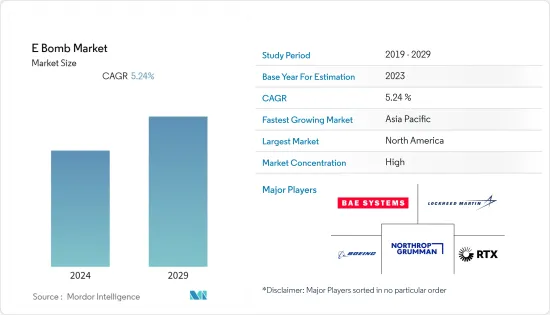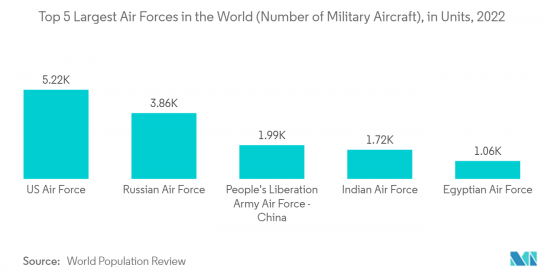
전자폭탄 시장은 2024년 52억 6,000만 달러로 평가되며 2029년에는 68억 달러에 달할 것으로 예상되며, 예측 기간 동안 5.26%의 CAGR로 성장할 것으로 예상됩니다.

전자폭탄(E-bomb)은 전자기 펄스(EMP)로 전자기기와 기계 시스템을 정지시키도록 설계된 첨단 무기다. 전기/전자 시스템과 결합하여 유해한 전류/전압 서지를 발생시킬 수 있습니다. 수폭은 강력한 전자기 펄스를 발생시켜 통신 시스템, 전자 회로, 인공위성, 컴퓨터, 변압기 등 전류에 의존하거나 전류를 전달하는 모든 것을 영구적으로 무력화시킵니다. 목표물을 파괴하거나 사람을 죽이지 않습니다.
고출력 마이크로파(HPM)의 사용 증가와 적의 이동 목표물, 함정, 이동 레이더, 방공 시스템 및 기타 전자 시스템을 대상으로 하는 군사 분야에서 전자폭탄의 사용 증가는 예측 기간 동안 시장 성장을 주도하고 있습니다. 현재 GPS 유도탄은 전략적 항공 공격에 매우 유용하기 때문에 수요가 증가하고 있으며, GPS 유도탄은 고급 센서, 제어 시스템 및 조정 가능한 비행 지느러미를 갖추고 있어 보다 정확한 유도 능력을 제공합니다. 군사 기술의 기술 발전, 차세대 무기 채택, 국방 역량 강화를 위한 지출 증가는 향후 몇 년 동안 시장 성장을 촉진할 것입니다. 한편, 전자폭탄의 효과는 전적으로 무기가 목표물에 도달하고 배치할 수 있는 운반 플랫폼의 능력에 따라 달라진다는 점에서 전자폭탄은 목표물 운반 수단과 관련된 한계가 있습니다. 이러한 요인들이 시장 성장을 방해하고 있습니다.
공군 부문은 예측 기간 동안 눈에 띄는 성장을 보일 것으로 보입니다. 이러한 성장은 국방 분야 지출 증가, 최첨단 전투기 조달 증가, 적의 전자 장비를 표적으로 삼는 차세대 전자폭탄의 채택에 기인합니다. 세계 군사비는 2022년 사상 최고치인 2조 2,400억 달러에 달할 것으로 예상됩니다. 국경 간 분쟁의 증가, 러시아-우크라이나 전쟁, 주변 국가의 정치적 갈등은 안보 위협을 증가시킬 것입니다. 이에 따라 세계 각국 국방부는 국방력 향상에 많은 투자를 하고 있습니다.
전자폭탄의 가장 큰 장점은 GPS 유도탄을 발사할 수 있는 항법 공격 시스템을 갖춘 전술기라면 어떤 기체라도 발사할 수 있다는 것. 전자폭탄은 수백만 와트의 마이크로파 에너지를 발사할 수 있어 전자 장비와 그에 의존하는 무기를 파괴할 수 있습니다. 예를 들어, 2023년 6월, 개선된 러시아의 전자전 시스템은 한 달 만에 약 1만 대의 우크라이나 무인기를 파괴하고 우크라이나의 전술 통신을 실시간으로 가로채고 해독할 수 있었습니다. 이처럼 첨단 전자폭탄의 채택이 증가하고 차세대 전투기 조달에 대한 지출이 증가함에 따라 예측 기간 동안 시장 성장을 견인할 것으로 보입니다.

북미 지역이 시장에서 가장 높은 점유율을 차지하고 있으며, 예측 기간 동안에도 그 지배력이 지속될 것입니다. 이러한 성장은 미국 정부의 국방비 지출 증가, 첨단 군사 무기 조달 증가, 최대 규모의 군용 항공기 존재에 기인합니다. 스톡홀름 국제평화연구소(Stockholm International Peace Research Institute)는 2022년 미국이 세계 최대 국방비 지출 국가로 8,770억 달러의 국방비를 지출할 것이라는 보고서를 발표했습니다. 미국 국방부(DoD)의 2024년 예산 요구는 선진 군수품 조달에 중점을 둔 국방 전략에 초점을 맞추고 있으며, 2024년 군수 예산은 306억 달러로 2023년 요구보다 58억 달러 증가했습니다. 예를 들어, 미 국방부는 방향성 에너지 집중형 전자기 에너지 무기의 설계 및 개발에 매년 10억 달러를 지출하고 있습니다. 현재 미 국방부는 드론과 미사일을 포함한 다양한 위협을 격퇴할 목적으로 지향성 에너지 무기를 개발하고 있습니다. 또한 각 부처는 군사 기지에 대한 미사일과 드론의 무차별 공격에 대응하는 등 다양한 용도로 사용할 수 있는 고출력 마이크로파 능력을 개발했습니다. 이처럼 안보 위협의 증가로 인한 첨단 무기 조달에 대한 지출 증가와 국방 능력 향상에 대한 관심이 높아지면서 이 지역 전체 시장 성장을 촉진하고 있습니다.
전자폭탄 시장은 매우 세분화되어 있으며, 소수의 기업이 시장에서 큰 점유율을 차지하고 있습니다. 시장의 주요 업체로는 Boeing Company, Raytheon Technologies Corporation, Lockheed Martin Corporation, Northrop Grumman Corporation, BAE Systems plc. 등이 있습니다. 주요 주문자상표부착생산(OEM) 업체들은 기술 발전과 정밀도와 신뢰성을 향상시킨 첨단 전자폭탄의 설계 및 개발에 매우 집중하고 있습니다. 예를 들어, 2019년 9월, 노스롭그루먼은 미 해군으로부터 FMU-139D/B를 생산하는 첫 번째 생산 주문을 받았습니다. 이는 미국 국방부와 그 동맹국이 사용하는 많은 범용 폭탄에 적합한 새로운 전자폭탄 퓨즈입니다.

The E-Bomb market is valued at USD 5.26 billion in 2024 and is expected to reach 6.8 billion by 2029, projecting a CAGR of 5.26% during the forecast period.
An electromagnetic bomb (E-bomb) is an advanced weapon designed to turn off electronics and mechanical systems with an electromagnetic pulse (EMP). It can couple with electrical/electronic systems to produce damaging current and voltage surges. E-Bomb generates a powerful EMP that permanently disables telecommunications systems, electronic circuitry, satellites, computers, electrical transformers, and anything that relies on or transmits electrical current. It does not destroy targets or kill people.
The increasing use of high-power microwaves (HPM) and the rising use of E-bomb in the military sector as they target the enemy's mobile targets, naval vessels, mobile radars, air defense systems, and other electronics systems is driving the growth of the market during the forecast period. Nowadays, there is increased demand for GPS-guided munitions as these are highly useful in strategic air attacks. The GPS-guided munition is equipped with advanced sensors, control systems, and adjustable flight fins that provide more accurate guidance capacity. Technological advancements in military technology, the adoption of next-generation weapons, and rising spending on enhancing defense capabilities will drive market growth in the coming years. On the other hand, there is a limitation of the E bomb related to its means of delivery to the target. The effectiveness of an E bomb completely depends on the delivery platform's ability to reach and deploy the weapon. Such factors hinder the growth of the market.
The Air Force segment will showcase remarkable growth during the forecast period. The growth is due to the increasing expenditure on the defense sector, growing procurement of advanced fighter jets, and adoption of next-generation e-bomb to target the electronic devices of enemies. Global military spending reached an all-time high of USD 2.24 trillion in 2022. Increasing cross-border conflicts, the Russia-Ukraine war, and political disputes in neighboring countries lead to increasing security threats. Thus, global defense forces are highly investing in improving their defense capabilities.
The major advantage of electromagnetic bombs is that they can be delivered by any tactical aircraft with a nav-attack system capable of delivering GPS-guided munitions. E-bombs can fire millions of watts of energy in microwaves that can knock out electronic equipment and the weapons that rely on them. For instance, in June 2023, an improved Russian electronic warfare system destroyed about 10,000 Ukrainian drones in a month and was able to intercept and decrypt Ukrainian tactical communications in real-time. Thus, the growing adoption of advanced E-bombs and rising spending on procurement of next-generation fighter jets is boosting the growth of the market during the forecast period.

North America holds the highest shares in the market and continues its domination during the forecast period. The growth is due to increased defense spending from the US government, rising procurement of advanced military weapons, and the presence of the largest military aircraft fleet. The Stockholm International Peace Research Institute published a report in 2022 that stated that the US is the largest defense spender in the world, with a defense budget of USD 877 billion. The US Department of Defense (DoD) 2024 budget request is focused on national defense strategy with more emphasis on procurement of advanced munition. The 2024 budget for munitions is USD 30.6 billion, an increase of USD 5.8 billion above the 2023 request. For instance, the US DoD spends USD 1 billion annually on the design and development of directed energy-concentrated electromagnetic energy weapons. Currently, the US DoD is developing directed energy weapons with the goal of defeating a range of threats, including drones and missiles. Furthermore, the departments developed a range of high-power microwave capabilities for various applications, such as engaging missile or drone swarm attacks against a military base. Thus, growing expenditure on procurement of advanced weapons due to rising security threats and increased focus on improving defense capabilities is driving the market growth across the region.
The E-bomb market is highly fragmented, with a presence of few players holding significant shares in the market. Some of the key players in the market are The Boeing Company, Raytheon Technologies Corporation, Lockheed Martin Corporation, Northrop Grumman Corporation, and BAE Systems plc. Key original equipment manufacturers (OEMs) highly focus on technological advancements and the design and development of advanced electromagnetic bombs with improved accuracy and reliability. For instance, in September 2019, Northrop Grumman Corporation received its first production order from the US Navy to manufacture the FMU-139D/B. It is a new all-electronic bomb fuze suitable for a number of general-purpose bombs used by the US Department of Defense and its allied nations.